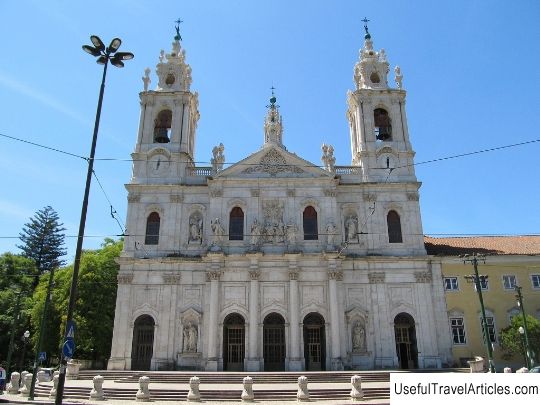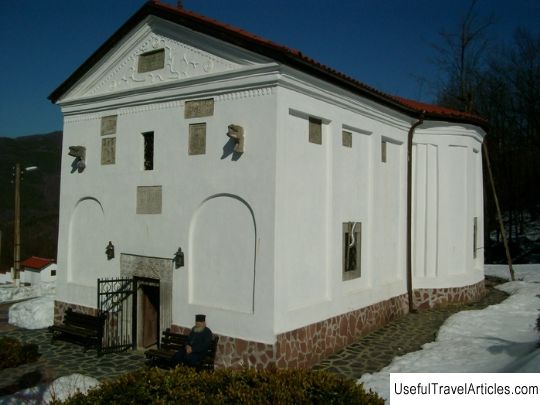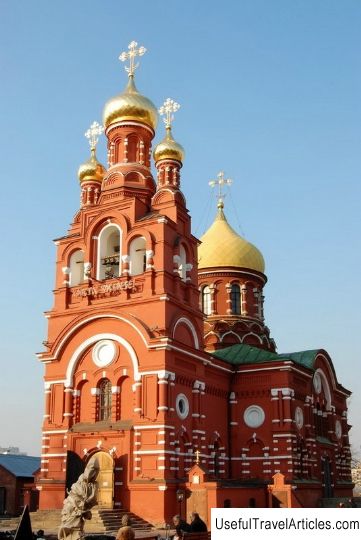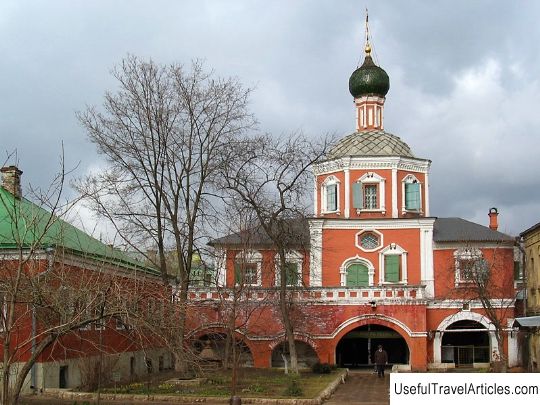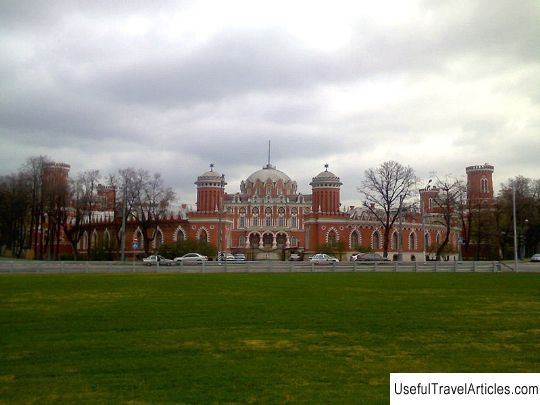Vysoko-Petrovsky Monastery description and photos - Russia - Moscow: Moscow
Rating: 7,5/10 (100 votes) 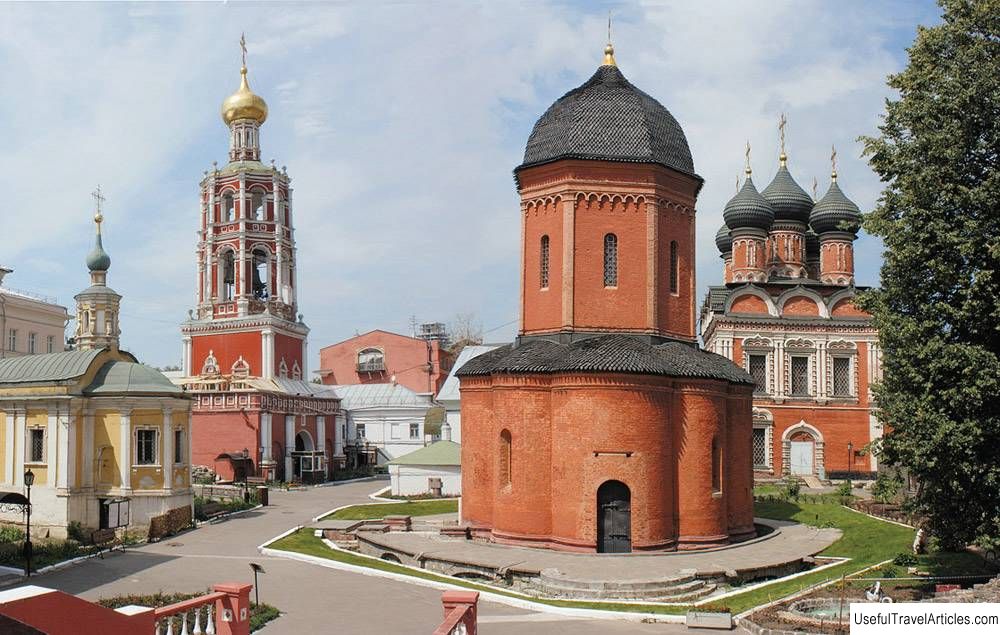
Vysoko-Petrovsky monastery description and photos - Russia - Moscow: Moscow. Detailed information about the attraction. Description, photos and a map showing the nearest significant objects. Photo and descriptionThe Orthodox men's monastery on Petrovka Street in Moscow was founded by the Metropolitan of Kiev, Vladimir and All Russia, Saint Peter. The monastery has had stavropegic status since the middle of the 18th century. This means that the Vysoko-Petrovsky Monastery is directly subordinate to the Patriarch of Moscow and All Russia. The architectural ensemble of the monastery, which has survived to this day, was formed mainly in the period from the 17th to the 18th centuries. The history of the founding of the Vysoko-Petrovsky MonasteryThe earliest documentary references to the monastery are contained in Rogozhsky Chronicler. The chronicle, compiled in the 15th century, was found in the archives of the Old Believers' Rogozhsky cemetery in Moscow. Historians do not have a consensus about who and when founded the monastery. The first version says that Saint Peter began building the monastery in 1315. Then the Metropolitan became especially close to Ivan Kalita . Perhaps the monastery was founded a little later - in 1326, when the metropolitan see was transferred to Moscow from Vladimir and Metropolitan of Kiev, Moscow and All Russia Peter moved to the current Russian capital. At first, the saint built a temple on the banks of the Neglinka and consecrated it in honor of the apostles Peter and Paul. The dedication remained unchanged until the beginning of the 16th century, when the church was re-consecrated in honor of Metropolitan Peter himself. Supporters of the alternative version believe that the monastery appeared in Moscow thanks to Ivan Kalita himself. Legend has it that the Grand Duke had a vision. While hunting, he saw a mountain covered with snow. The mountain soon disappeared in the same miraculous way as it appeared, and the snow on it had previously melted. Hearing about the vision, Metropolitan Peter interpreted it as his approaching death. In memory of his spiritual father, Ivan Kalita built the Peter and Paul Church, around which a monastery was formed, called at that time Peter and Paul. In 1514 the Italian architect New Aleviz builds the first stone church in the Vysoko-Petrovskaya monastery. According to his project, a wooden Church of the Intercession of the Most Holy Theotokos is being erected over the graves of the Naryshkin boyars killed by the archers during the riot. It was then that the monastery began to be called Vysoko-Petrovsky. The period that began at the end of the 17th century became the flourishing of the monastery. The area of the monastery almost doubles: the lands of the Naryshkins' estate are transferred to it, and the boyars themselves donate huge funds for the development of the monastery and the construction of its facilities. In the 90s of the 17th century, Bogolyubskaya Church was built on the site of the lost Pokrovsky Church, Sergievskaya Church in the image and likeness of the Lavra of the same name in the Trinity-Sergius Lavra, gate church with a two-tier bell tower and various residential and business facilities. From Napoleon to the Revolution The Patriotic War of 1812 caused serious damage to the monastery. Like many churches and monasteries in Moscow and Russia, Vysoko-Petrovsky was ravaged by Napoleon's soldiers , who stood at the monastery on a guard. The temples and tombstones of the boyars Naryshkins buried in the monastery were desecrated, the iconostasis served as a place for attaching hooks to which the meat was hung, and the Frenchmen accused of arson were shot right at the walls of the monastery and buried at the bell tower. After the victory over Napoleonic Moscow was restored by the army, and the Vysoko-Petrovsky Monastery gradually began to play an important role in strengthening Russian spirituality. In 1822, a theological school was transferred here, and in the second half of the 19th century, the Moscow diocesan library was placed in the monastery. At the same time, the monastery hosted meetings of the Society of Lovers of Spiritual Education. Formally, the Vysoko-Petrovsky Monastery was closed in 1918, immediately after the Bolsheviks came to power. Residential buildings were transferred to the housing stock, but the temples continued to operate for some time. A underground monastic community arose in the monastery, which managed to survive until 1929. It was then that the last monastery church was closed. The new government destroyed the tombstones of the Naryshkins necropolis. A repair shop was opened in the church of the Bogolyubskaya Icon of the Mother of God. In other churches and cathedrals, a sports hall, a library and even a foundry were placed, and communal apartments were equipped in the cells and the abbot's building. In the 50s of the twentieth century, the monastery was supposed to be demolished altogether in order to widen the road, but the Ministry of Culture managed to assign it the status of an architectural monument and save it. In 1 994 the architectural ensemble and the territory of the Vysoko-Petrovsky monastery in Moscow were transferred to the Russian Orthodox Church. The decision to revive monastic life was made by the Holy Synod in 2009. A large-scale restoration of the architectural objects of the monastery was completed in 2018. What to see in the monastery The architectural ensemble of the Vysoko-Petrovskaya monastery has been formed since the 16th century. On the territory of the monastery, you can see several architectural monuments included in the lists of the cultural heritage of the peoples of Russia. - The main church of the monastery bears the name of St. Peter Metropolitan of Moscow . He is the model of the church, at the base of which is not a square or a rectangle, but a combination of semicircles. On the plan, the temple looks like a flower with eight petals. The octagonal tower of the cathedral is crowned with a single helmet-shaped dome. The temple was built of stone at the beginning of the 16th century, and a century and a half later it was rebuilt by the Naryshkins boyars. By their order, the cathedral received elements of the Moscow Baroque - the windows became wider, their openings were decorated with carved platbands, the portals acquired an elegant look, and the best masters of the Armory Chamber worked on the six-tier iconostasis. Unfortunately, in Soviet times, the cathedral was not used for its intended purpose and its iconostasis was lost. - At the end of the 17th century in the Vysoko-Petrovsky monastery there was a temple of the Bogolyubskaya icon of the Mother of God , built on the site of a church in honor of the Protection of the Most Holy Theotokos. Tsar Peter and Tsarina Natalya Kirillovna donated to the temple a copy of the miraculous image of the Bogolyubskaya Icon of the Mother of God, kept in the monastery of the village of Bogolyubovo near Suzdal. The Bogolyubsky Cathedral of the Vysoko-Petrovsky Monastery was built in the style traditional for the 17th century. Its facades are decorated with keeled kokoshniks, the proportions of the windows seem slightly elongated, and the drums supporting the heads are decorated with an arcature-columnar belt. The iconostasis, created in 1687 by Klim Mikhailov, contained icons painted by the best masters of the 17th century. They were all burned after the revolution. Then the cross and the dome were destroyed. Inside the church, only fragments of stucco and murals of the 18th century have survived. - The construction of the refectory church of St. Sergius of Radonezh was completed in 1702. To create it, the architects chose the Naryshkin Baroque style. The temple divides the territory of the monastery in two and is adjacent to the refectory of the monastery. The external decor of the temple is made with white stone, from which the platbands, framing of the entrance gates and shells in decorative kokoshniks are carved. - A small one-domed Church of the Tolga Icon of the Mother of God was built in Vysoko Petrovsky Monastery in the middle of the 18th century. Funds for the construction of the temple were donated by the lady of state and a relative of Tsar Peter I, N.A. Naryshkina. The temple was consecrated in honor of the Tolga Icon of the Mother of God, a list of which was written by Ivan Andreev in 1740. The iconostasis of the church, made of ceramics, is worthy of attention. - In 1905, a small chapel was built in the southern span of the gate to the monastery, which was consecrated in honor of the Kazan Icon of the Mother of God . The image was lost after the revolution, like many others, and the chapel was destroyed. It was restored in 2001, and today akathists are performed in the chapel. - The most beautiful structure of the monastery, the gateway church of the Intercession of the Most Holy Theotokos was erected at the end of the 17th century over the western gate. The architectural dominant of the monastery is often called the bell tower of the Pokrovskaya Gate Church, which consists of two octahedrals with numerous arches and is richly decorated with panels, pilasters and stucco. The bell tower is crowned with a head in the form of a gilded onion. Since its inception Vysoko-Petrovsky Monastery has collected many shrines, and his sacristy was considered one of the richest among its kind in the monasteries of Moscow and other cities. The pilgrims who came to the monastery could pray at silver crosses with particles of the Cross of the Lord, venerate the relics of the great martyrs Panteleimon and Feodor Stratilat, be near the miraculous icons copied from the images of the Bogolyubskaya, Tolgskaya and Vladimirskaya Mother of God. After the revolution, the new government did not just close the monastery churches. The shrines were destroyed or plundered, and many monks and parishioners of the monastery were martyred in the dungeons of the NKVD. Today, new shrines have appeared in the monastery, to which thousands of pilgrims come. The most significant believers consider particles of the relics of Saint Seraphim of Sarov, a fragment of a stone, on which the saint performed prayers for a thousand days and nights, and a rag from his mantle. Part of the relics of St. Sergius of Radonezh is also kept in the Vysoko-Petrovsky monastery. The most revered icon of the monastery depicts St. Peter of Kiev, Moscow and All Russia, who was the first metropolitan of Moscow. The growth icon of St. Peter contains a particle of his relics and is revered as miraculous. In the Sergievsky temple, pilgrims can bow to the relics of the holy apostles Peter and Paul. Notes
         We also recommend reading Piton de la Fournaise volcano description and photos - Reunion Topic: Vysoko-Petrovsky Monastery description and photos - Russia - Moscow: Moscow. |
